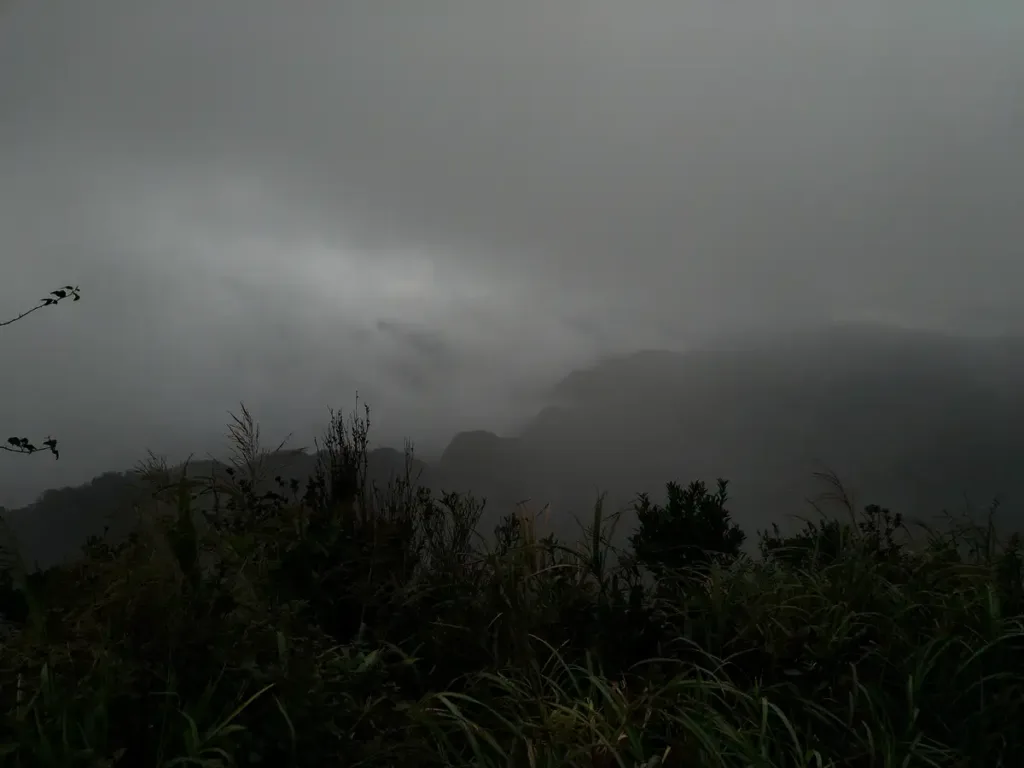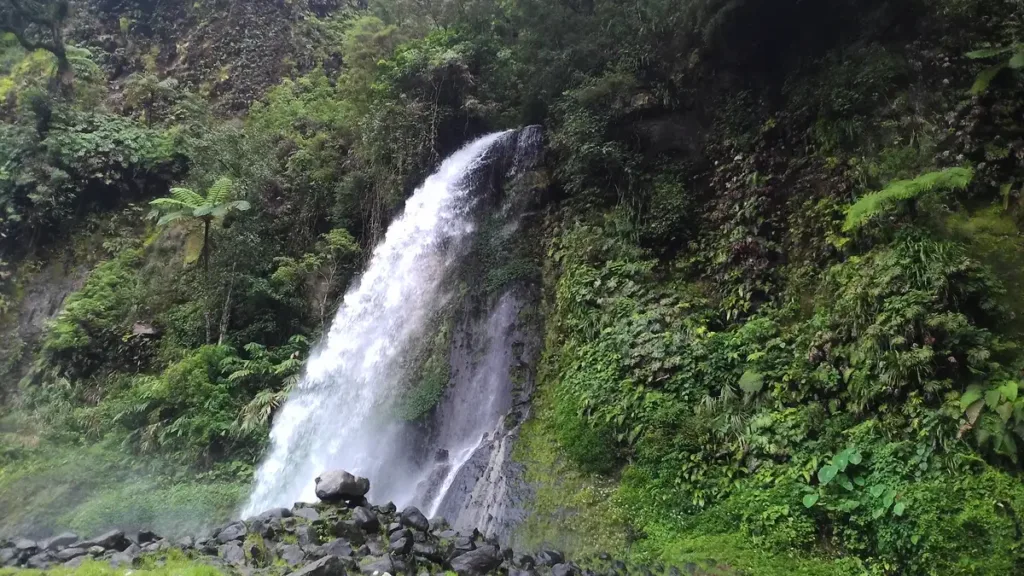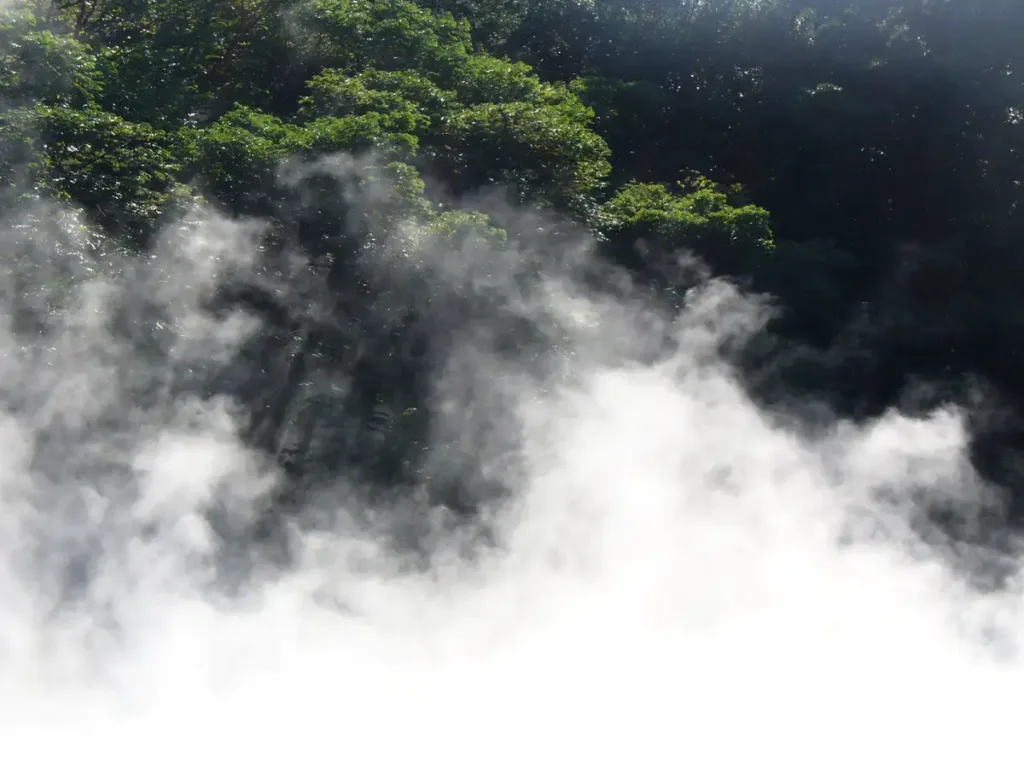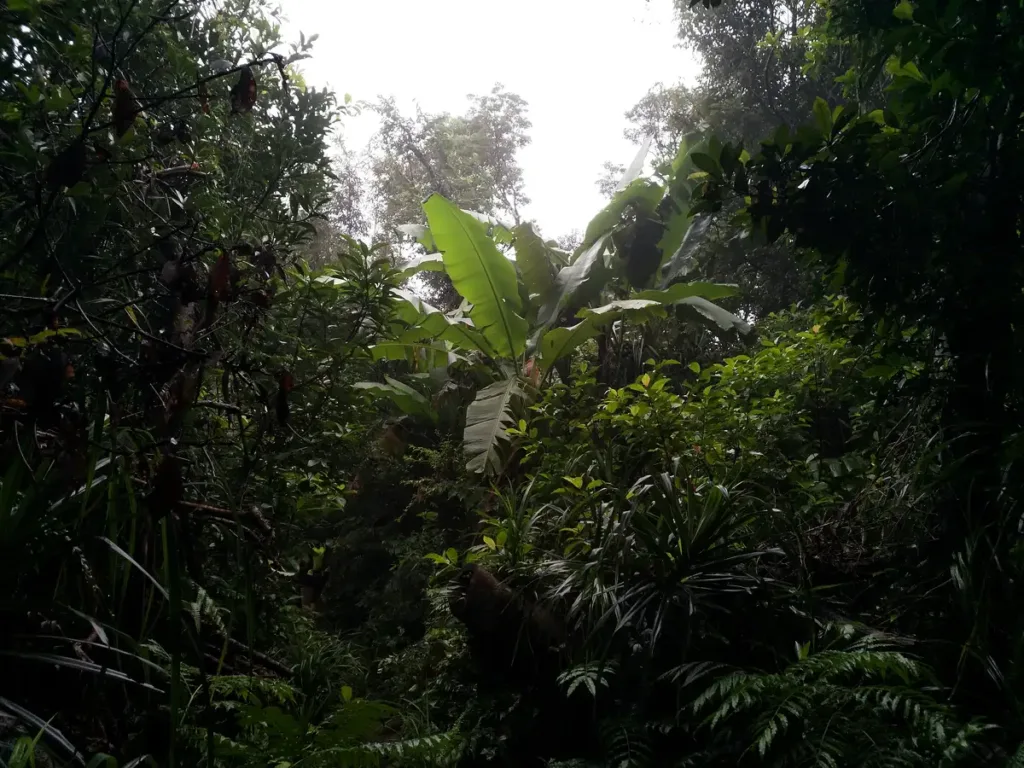Hiking in the rain: 5 Tips to stay comfortable when it’s wet
This post may contain affiliate links. This means that we may receive a small commission from purchases through those links. Read more in our affiliate disclosure.
Ah, rain! Some see it as a curse on their outdoor plans, but not us! We see it as an opportunity to experience the trail in a new and refreshing way. There’s a certain charm to hiking in the rain, a tranquil serenity that you just can’t find on a clear day.

In this guide, we’ll explore the essentials of hiking in the rain, from choosing the right trail and wearing proper clothing to protecting your gear and embracing the beauty of a wet day on the trail. Let’s dive right in, shall we? (Not literally. That’s too wet.)
Choose the right trail
Rainy weather can add a mystical touch to your hiking experience, but it also brings new challenges and hazards. Choosing the right trail becomes an essential part of your planning.
Trail Hazards
- Slippery slopes: Trails that may be simple during dry weather can become treacherously slick when wet. Roots and rocks become obstacles to navigate with care. Investing in hiking poles can improve stability and choosing trails with gravel or sand surfaces can mitigate this risk.
- Swollen creeks: Even a small creek can become a raging river after heavy rain. What was a casual rock-hop on the way in can be a life-threatening crossing on the way out. Look for bridges or solid crossing points and always have a backup plan.
- Flash floods: Particularly in desert canyons or areas prone to sudden storms, flash floods can happen quickly. Always check weather forecasts, know the terrain, and be prepared to change plans if necessary. Safety must always be the priority.
- Hypothermia: Wet clothing loses its insulating properties, making you more susceptible to hypothermia, even in relatively mild temperatures. Quick-drying fabrics and layering can prevent this danger.
- Dehydration: It seems counterintuitive, but it’s easy to forget to drink water when you’re surrounded by it. Staying hydrated is crucial, even in the rain. Monitor your water intake just as carefully as on a sunny day.
What trails to choose in the rain
Selecting the right trail when it’s raining requires a different mindset:
- Well-Drained Soil Trails: Choosing trails with sandy or rocky soil helps avoid the dreaded “mud slog.” These trails remain more stable and comfortable to walk on even during a downpour.
- Forested Trails: Trails under the canopy of trees can provide natural shelter from the rain. The sound of raindrops on leaves adds a soothing soundtrack to your hike.
- Avoid Steep Climbs: Rain can make steep climbs not only challenging but dangerous. Stick to flatter terrain where the risk of slips and falls is minimized.
- Embrace Waterfalls and Streams: Trails near waterfalls and streams can be especially magical in the rain. The increased water flow turns ordinary falls into spectacular sights.a hiking poles

Wet weather clothing
Rain on the trail need not be a deterrent; it’s an opportunity to explore nature’s different moods. The right attire makes all the difference. Let’s explore the intricacies of the clothing options that keep you comfortable in wet weather.
Materials
Materials matter most when it comes to choosing the right clothing. Here’s what you need to know:
- Avoid Cotton: Once hailed as the fabric of our lives, cotton quickly loses its appeal in the rain. Wet cotton sticks to your skin, saps your body heat, and takes forever to dry. It’s a no-go for rainy hikes.
- Synthetic Fabrics: Polyester and nylon are the heroes of the rainy trail. These materials pull moisture away from the skin, allowing it to evaporate, keeping you dry and warm. Lightweight and quick-drying, they’re perfect for base layers.
- Wool: Wool is like nature’s miracle fabric. It can absorb a significant amount of moisture without feeling wet, retains heat even when damp, and is naturally odor-resistant. Merino wool, in particular, offers a soft feel without the itchiness of traditional wool. It’s an ideal choice for socks, hats, and base layers.
Rain Jacket
A good rain jacket is your first line of defense against a downpour. Here’s how to select the best:
- Hard Shell vs Soft Shell: Hard shell jackets provide a waterproof barrier but might compromise breathability. Soft shells offer more flexibility and breathability but may not be entirely waterproof. Your choice depends on the intensity of rain you expect and how much you’ll be exerting yourself.
- Taped Seams: Look for jackets with taped seams. These prevent water from sneaking in through the stitch holes, a common weak point in jackets.
- Fresh Water Repellent (DWR): A DWR coating makes water bead up and roll off the fabric, enhancing the jacket’s waterproofness. Regularly treating your jacket with a DWR spray will keep it functioning at its best.
- Pit Zips and Ventilation: Ventilation options help manage body heat and moisture. Look for jackets with pit zips or other venting features, especially if you plan on intense hiking.
- Adjustable Hood: An adjustable hood that fits well over your head or a helmet is essential. Look for hoods that offer a brim to keep rain out of your eyes.
Rain Pants
Rain pants are often overlooked but are crucial to staying dry:
- Material: Like rain jackets, look for pants with a DWR treatment and taped seams.
- Fit: Look for a comfortable fit that allows for layering underneath but isn’t too baggy, which can lead to snagging on branches.
- Side Zippers: These allow you to put on or take off the pants without removing your boots, a significant advantage if rain starts unexpectedly.
Gaiters
A hiker’s hidden gem, gaiters perform the vital task of keeping your feet and lower legs dry:
- Material: Seek gaiters made of waterproof yet breathable fabric. Look for models with a DWR finish to make sure moisture stays away.
- Length: Gaiters come in various lengths, from ankle to knee. Ankle gaiters are lighter and ideal for less rugged trails, while knee-length gaiters offer better protection in dense brush or snow.
- Attachment: Ensure they fit well with your specific hiking boots, fastening securely to prevent water and debris from entering.
Footwear
Rain brings a whole new dimension to choosing footwear. You have two possible ways to go:
- Waterproof Boots: These can be excellent for keeping feet dry, but consider breathability. GORE-TEX lining is a popular choice, offering waterproofness and some breathability.
- Hiking Sandals: In warm, rainy conditions, hiking sandals may be preferable. Select those with sturdy soles and a deep profile. The open design allows water to flow through, and your feet dry quickly.
Rain Hat
A rain hat keeps the water from hitting your face, making the whole experience much more comfortable.
- Wide Brim: A wide-brimmed rain hat not only keeps your head dry but funnels rain away from your face and neck.
- Material: Consider lightweight, waterproof materials. Some hats even include a strap to keep them secure in windy conditions.
Anti-Blister Supplies
Wet conditions make it easier for nasty blisters to form, so bring precautions:
- Extra Hiking Socks: Wet feet are prone to blisters. Keep extra pairs of quick-drying, moisture-wicking socks at hand. Merino wool is again a great choice here.
- Blister Kits: Carry specific blister treatment supplies like moleskin, blister plasters, and antiseptic wipes. Knowing how to apply them properly can save a hike from becoming a painful ordeal.
Bring a Dry Change of Clothes
- Waterproof Bag: Having a complete dry set of clothes packed in a waterproof bag can be a game-changer. It provides the comfort and morale boost that may be needed at the end of a wet hike.
Use Contacts
- Avoid Glasses: In a heavy downpour, glasses become more of a hindrance than help. Raindrops obscure vision, and wiping them clear becomes a constant battle. If possible, use contacts or pack an anti-fog cloth. In fact, rain was the only reason I ever made myself get used to contacts – and it was totally worth it!
Protect your backpack from the rain
A backpack is the lifeline on the trail. It carries the essentials that make the hike possible, enjoyable, and safe. During a rainy hike, protecting the backpack and its contents is paramount. Here’s how to ensure that everything stays dry:
Rain Cover
A rain cover is like an umbrella for your backpack:
- Fit: Choose one that fits snugly around your pack. Too loose, and it can flap in the wind; too tight, and it may not cover the pack completely.
- Waterproof Material: Look for rain covers made from ripstop nylon with a waterproof coating.
- Visibility: Some rain covers come in bright colors or with reflective elements, enhancing your visibility in low-light conditions.
Pack Liners
While rain covers protect the outside, pack liners safeguard the contents:
- Trash Compactor Bags: A simple yet effective solution. These thick plastic bags line the inside of your pack, creating a waterproof barrier.
- Specialized Pack Liners: Available in various sizes, these are tailored to hiking backpacks and often feature a roll-top closure for added protection.
Dry Sacks
Dry sacks are the individual vaults for your valuables:
- Different Sizes: Utilize various sizes for different items. For example, use smaller sacks for electronics and larger ones for clothing.
- Colors: Consider color-coded sacks to quickly identify contents. Red for first aid, blue for food, etc.
- Closure: Roll-top closures with a buckle are generally the most secure. Ensure they are properly sealed.
Protect your electronics
Your gadgets need special attention:
- Waterproof Gadget Cases: Specialized cases offer robust protection. Look for ones that are submersible to a specific depth for maximum security.
- Ziploc Bags: For a cost-effective solution, placing your smartphone or other small electronics inside a ziploc bag can work wonders. Make sure it’s properly sealed, and consider double-bagging for added security. You can even use your touch screen through a ziploc!

Nutrition & Hydration
Embarking on a hike in the rain not only touches the soul but also engages the body in a unique physical challenge. The requirements for nutrition and hydration might subtly shift, and here’s how to adapt:
Bring easy on-the-go snacks
A rainy hike is no time for a picnic. The need is for fuel that’s accessible, quick, and doesn’t require you to stop – since stopping would make you cool down, the last thing you want to risk during rainfall. Consider these options:
- Energy Bars and Gels: Compact, calorie-dense, and wrapped for protection, these are designed for efficiency. Look for ones with a balance of carbs, fats, and proteins.
- Trail Mix: Customizable to taste and dietary needs, a good trail mix offers a variety of textures and flavors. Include nuts for healthy fats, dried fruit for quick energy, and perhaps some dark chocolate for a morale boost.
- Pre-made Sandwiches: Wrapped in foil or a reusable sandwich bag, a pre-made sandwich offers something more substantial without the need to cook.
- Fruit: Apples, oranges, and other less fragile fruits can be a refreshing palate cleanser.
Don’t forget to drink water
Rain may be all around you, but that doesn’t mean it’s inside you. Staying hydrated is as vital in the rain as in the sun:
- Water Sources: If relying on natural water sources, consider that rain might affect their availability and quality. A stream that’s a trickle one day might be a torrent the next. Plan accordingly. Sometimes, on the other hand, you can find plants such as ferns perching high up in the trees collecting and funnelling the fresh rain water, and sending it down in a stream perfect for a quick sip – keep an eye out for such opportunities!
- Treat collected water: Always treat natural water sources. Whether using a filter, purifier, or chemical treatment, make sure it’s compatible with the conditions you’ll encounter. This doubly applies for a freshly swollen stream of water; it might carry all kinds of nasty pollutants freshly picked up from the riverbank or forest floor.
- Bring a Hot Beverage: Packing a thermos with hot tea, coffee, or broth can be both a comfort and a way to stave off chill.
Embrace the Rain
Hiking in the rain isn’t about avoiding the drops or waging a battle against nature’s mood. It’s about an embrace, a partnership with the rain that can turn a dreary forecast into a joyous adventure.
Don’t Make a “Rain Face”
Making the “rain face” (you know what I mean) extends beyond a mere physical expression; it embodies a mental state that can color your entire experience. Scowling at the rain, resenting its intrusion on your hike, won’t keep you dry, nor will it enhance your journey. Instead, embracing the rain transforms the experience.
Try mindful hiking, taking a moment to feel the rain on your skin, listen to its rhythm on the leaves, and see how it revives everything around you. This mindfulness approach can turn the rain from an obstacle into a companion, from a hindrance into a harmony. It’s a shift in perception that can transform a rainy hike into an opportunity for connection, reflection, and joy. It’s about trading the “rain face” for a smile, the frustration for fascination, the battle for a dance. It’s a subtle but profound shift that makes all the difference on the trail.

Benefits of Hiking in the Rain
Contrary to common misconceptions, the rain brings a plethora of benefits:
- Fewer People: Popular trails become private sanctuaries. The solitude enhances the connection with nature and adds a tranquil quality to the hike.
- Beautiful Green Scenery: Rain nourishes the plants, resulting in lush landscapes, vibrant flowers, and an intoxicating fresh scent that can only be found in the rain.
- Cooler Temperatures: In hot climates, rain can provide a refreshing respite. It cools down the temperature, making the hike more comfortable.
- Wildlife Encounters: Some animals are more active during or after a rain, providing unique opportunities to observe them.
- Unique Photographic Opportunities: Rain transforms ordinary scenes into magical landscapes. Whether it’s the reflection in a puddle, raindrops on a spiderweb, or a rainbow breaking through the clouds, it adds a touch of magic for photographers.
To hike in the rain is to dance with nature in one of its purest forms. It’s a waltz that swirls to the tempo of falling drops, guided by the wind, narrated by thunder, illuminated by lightning, and painted by the colors of the wet world.

It’s not about the destination; it’s about the journey. The rain doesn’t dampen the spirit of the hike; it elevates it, infuses it with a wild charm that’s different from anything experienced in fair weather.




